Collections Highlights
The museum collections at the Pennsylvania German Cultural Heritage Center at Kutztown University preserve the vibrant and unique material culture of the Pennsylvania Dutch and the broader folk culture of Pennsylvania over three centuries.
This portion of our website is currently under construction. Check back with us again soon for more online collections highlights, thematic exhibitions, and virtual tours!
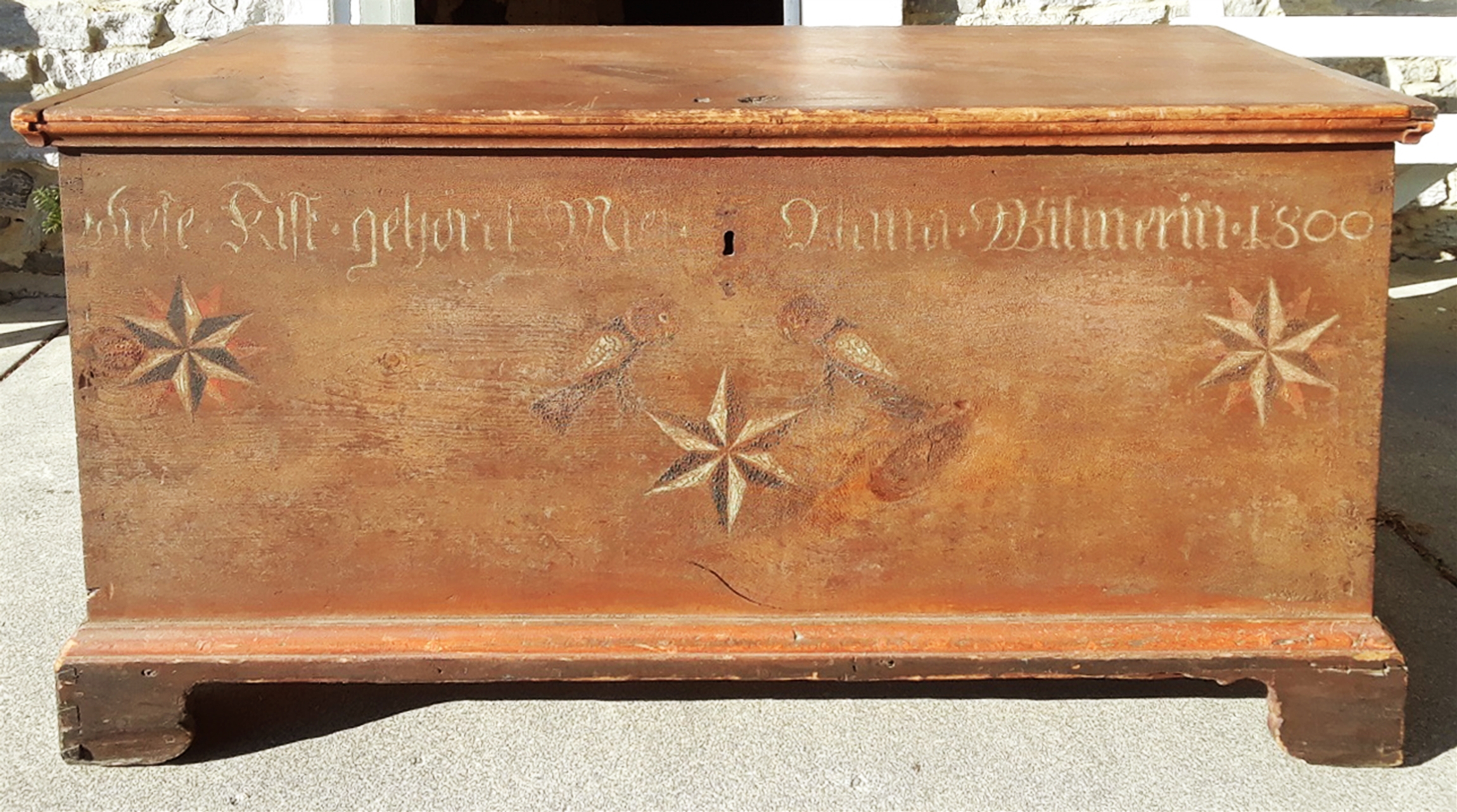
Mina Witmer Blanket Chest: Rapho Township, Lancaster County, 1800
The prolific furniture maker John Flory (1767-1836) created this decorated blanket chest featuring a pair of parrots and three geometric stars for Mina Witmer in 1800. The German inscription reads "Diese Kist gehöret mier Mina Witmerin 1800" (This chest belongs to me, Mina Witmer 1800). These ‘dower chests’ were traditionally produced for women of marrying age, and were filled with domestic provisions necessary for establishing a new household. For some women, these chests may be among the only surviving evidence recording their lives in early Pennsylvania.

Conrad Gilbert Fraktur House Blessing: Brunswick Township, Schuylkill County, 1784
This hand-written house blessing, entitled “A Beautiful Christian House Blessing for All Pious House Fathers and House Mothers” (Ein schöner Christlicher Hauß segen, für alle fromme Hauß väter und Hauß mütter), was penned by Johann Conrad Gilbert (1743-1812), for the family of Adam Schmidt of Tulpehocken Township, Berks County. Gilbert was a schoolmaster and prolific fraktur artist who created the earliest known images of the Easter rabbit in North America. The blessing offers comforting words of advice for Pennsylvania Dutch households, meant to be displayed and read aloud on special occasions and in times of trouble.
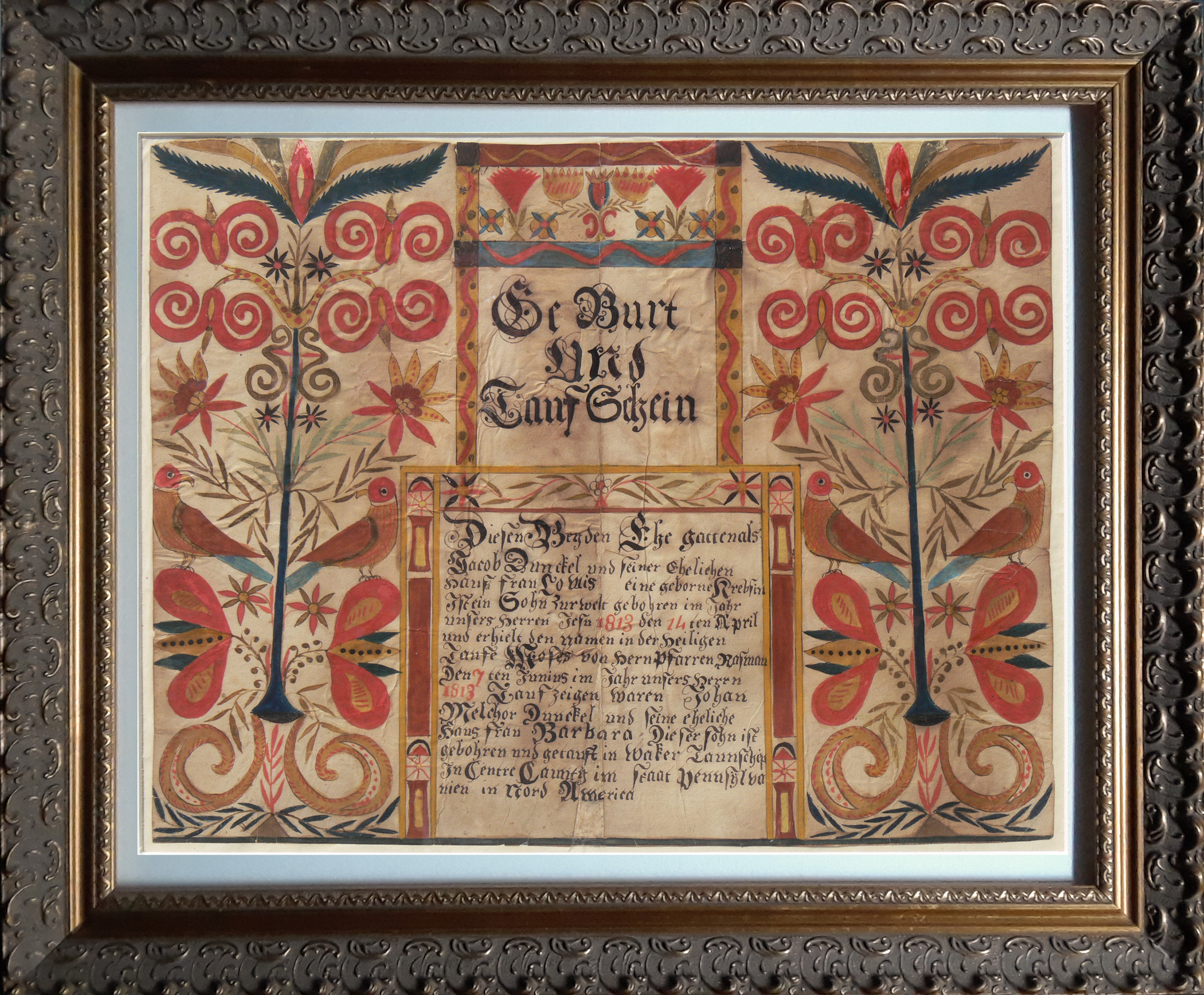
Moses Dunckel (Dunke) Birth and Baptismal Certificate: Walkter Township, Centre County, 1813
This colorful certificate (Taufschein) was created to commemorate the birth and baptism of Moses, son of Jacob and Lowis (Krebs) Dunckel , on April 14, 1813. The certificate records the birth location, as well as the name of Rev. Rasman who baptized him in the presence of Johan Melchior and Barbara Dunckel on June 7 1813. The Dunkel family, connected with the establishment of Dunkel’s Union Church near Kutztown, moved to Central Pennsylvania. Like many other Pennsylvania Dutch families in the nineteenth century, Moses Dunkel and his family later moved west, where he died in Plainfield Township, Will County, Illinois in 1865.
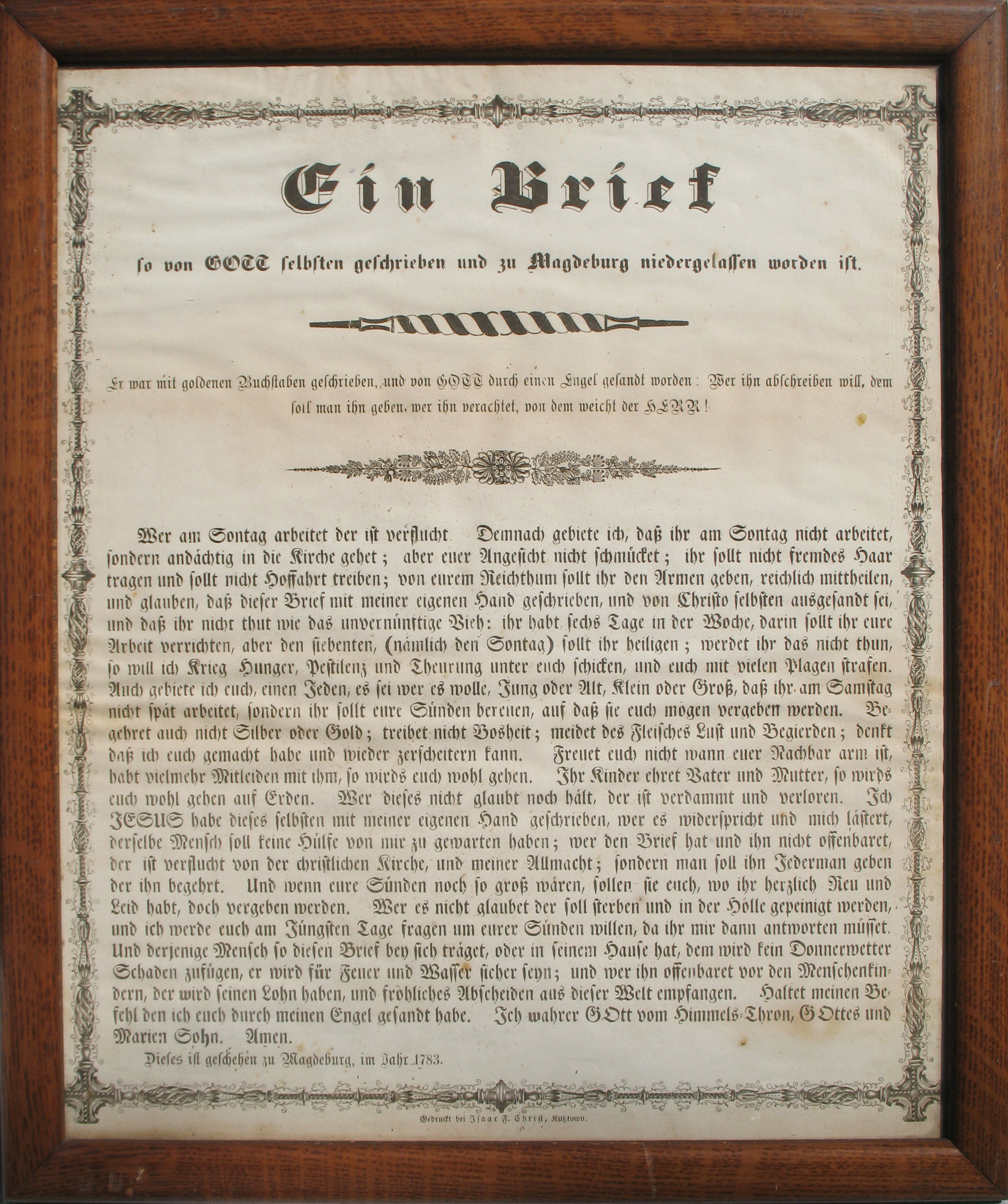
Isaac F. Christ Kutztown Himmelsbrief: Kutztown, Pennsylvania, 1870
A Pennsylvania Dutch "Letter from Heaven," or Himmelsbrief, printed in 1870 in Kutztown, Pennsylvania by Isaac F. Christ (1840-1904) publisher and printer of the local newspapers "The American Weekly Patriot" in English, and the "Kutztown Journal" in German. This document, was widely circulated in Pennsylvania in various printed and hand-written versions, serving as a house-blessing and a talisman for soldiers, promising extra-biblical revelations to pious people.
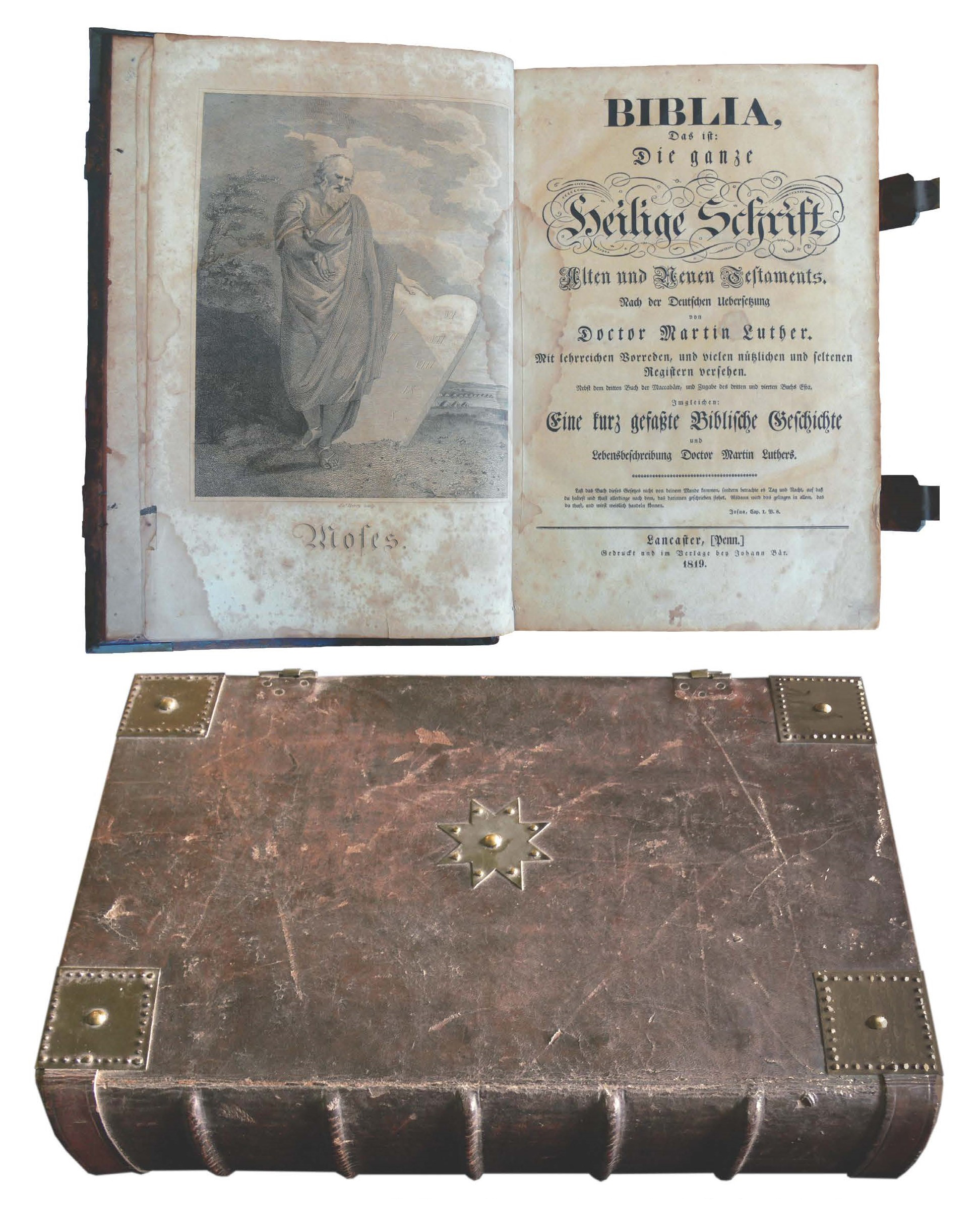
Johann Baer Folio Bible: Lancaster, Pennsylvania, 1819
The first folio Bible printed in North America, by Johan Baer (1782-1858), the Lancaster publisher and editor of the widely circulated German Newspaper, the Volksfreund, and the classic Baer’s farmer’s Almanac. In 1817, in Baer took over the unsuccessful plan of Joseph Ehrenfried (1782-1863) to issue America’s first folio Bible. Baer advertised the project in every issue of the Volksfreund newspaper in 1819, and included a list of subscribers, by state, county, and township at the conclusion of the Bible.
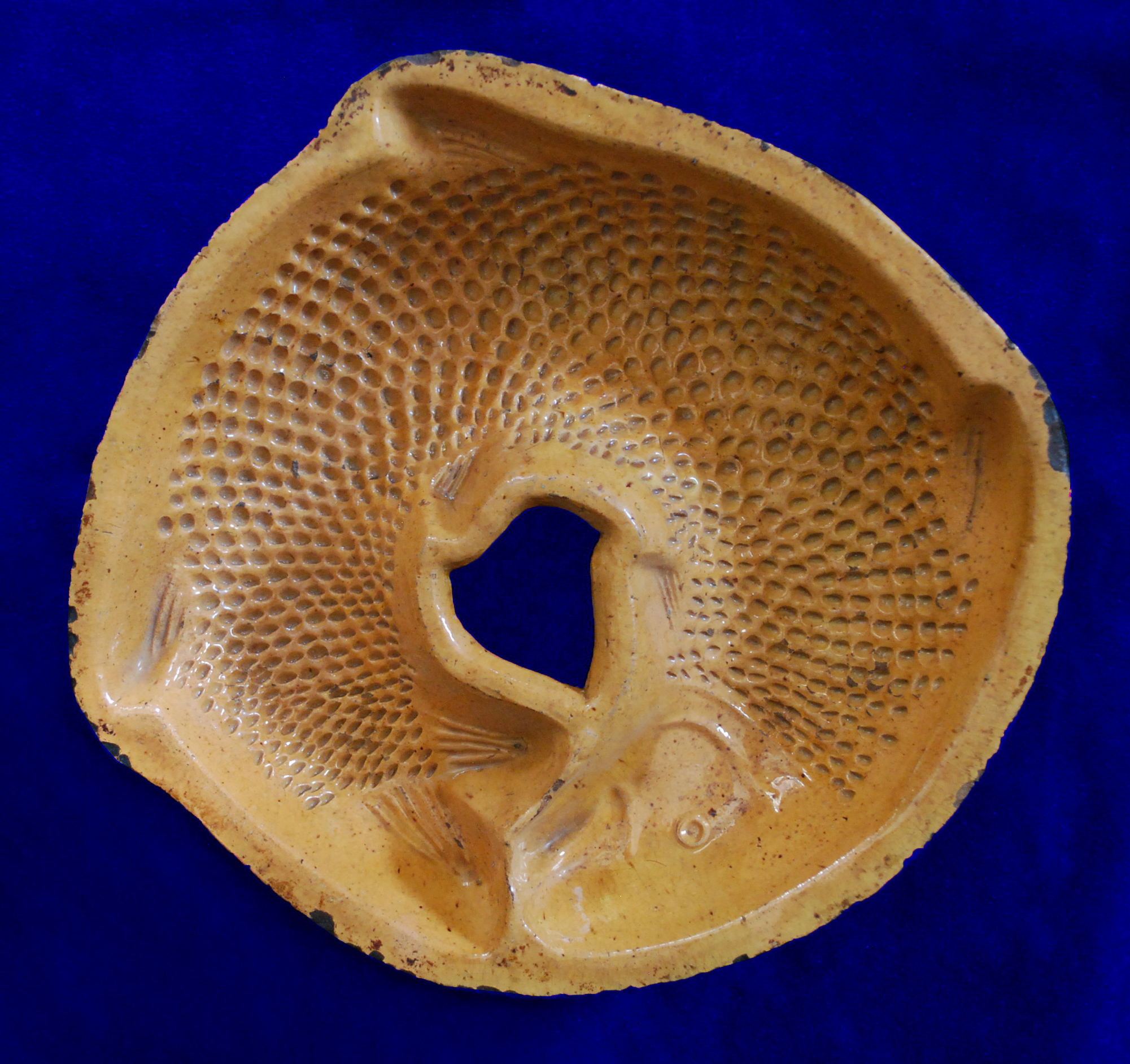
New Year's Fish Cake Mold: Western Berks County, ca. 1810
This early nineteenth-century redware pottery mold was carefully shaped to produce a shallow, circular, fish-shaped cake, typically baked to celebrate the new year. This tradition was once common in the Rhine River Valley in the German Palatinate, as well as Alsace, France where the "moule à poisson pour gâteaux de nouvel-an" (fish mold for new year’s cake) is still widely used. The significance of the fish as the herald of the new year comes from the Roman calendar, when March was the first month of the year. The zodiac sign of Pisces the fish bridges the last month of the old year and the first month of the new year.
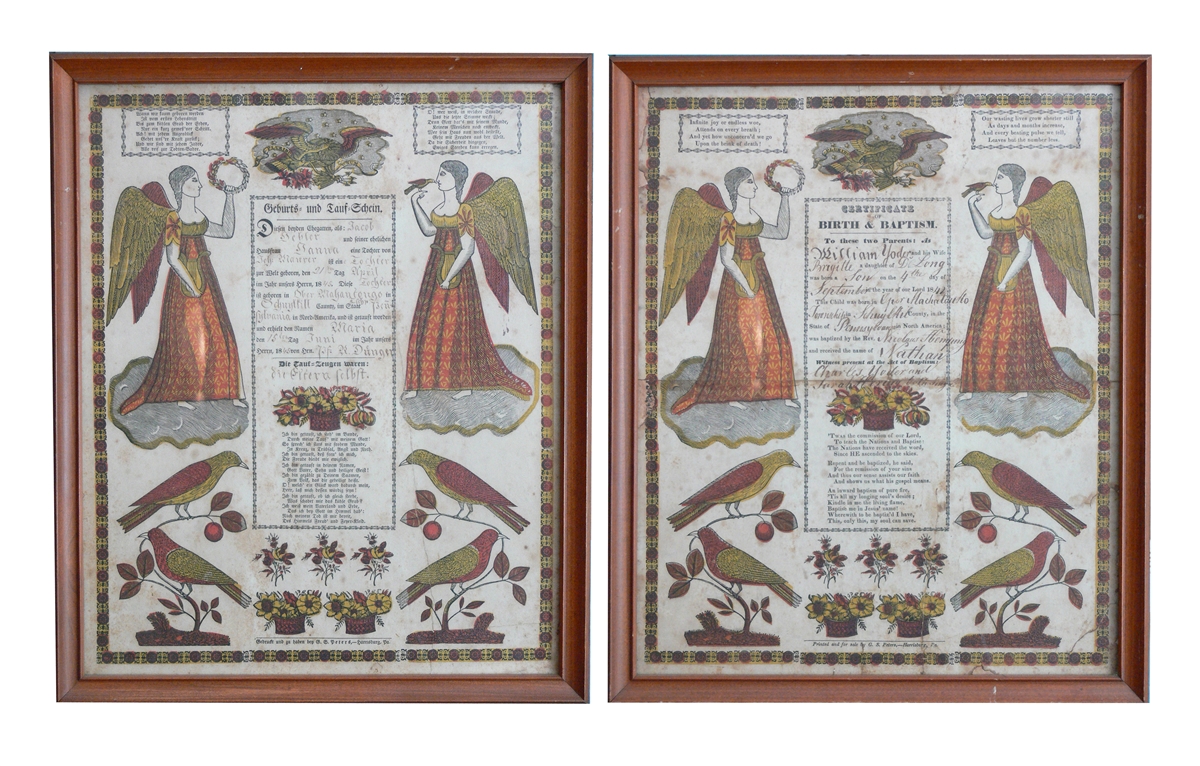
Yoder-Helper Family Birth and Baptismal Certificates: Upper Mahantango, Schuylkill County, 1842 & 1845
A pair of birth and baptismal certificates for Nathan Yoder (1842-1914) and Maria Hepler (1845-1924) of Upper Mahantango, Schuylkill County, and paternal grandparents of Dr. Don Yoder, Father of Folklife Studies in North America. The two certificates, printed in both English and German, were the work of Gustav S. Peters of Harrisburg, the first successful color printer in the United States, who used a classic layout with two angels widely accepted as the standard certificate form throughout Pennsylvania.
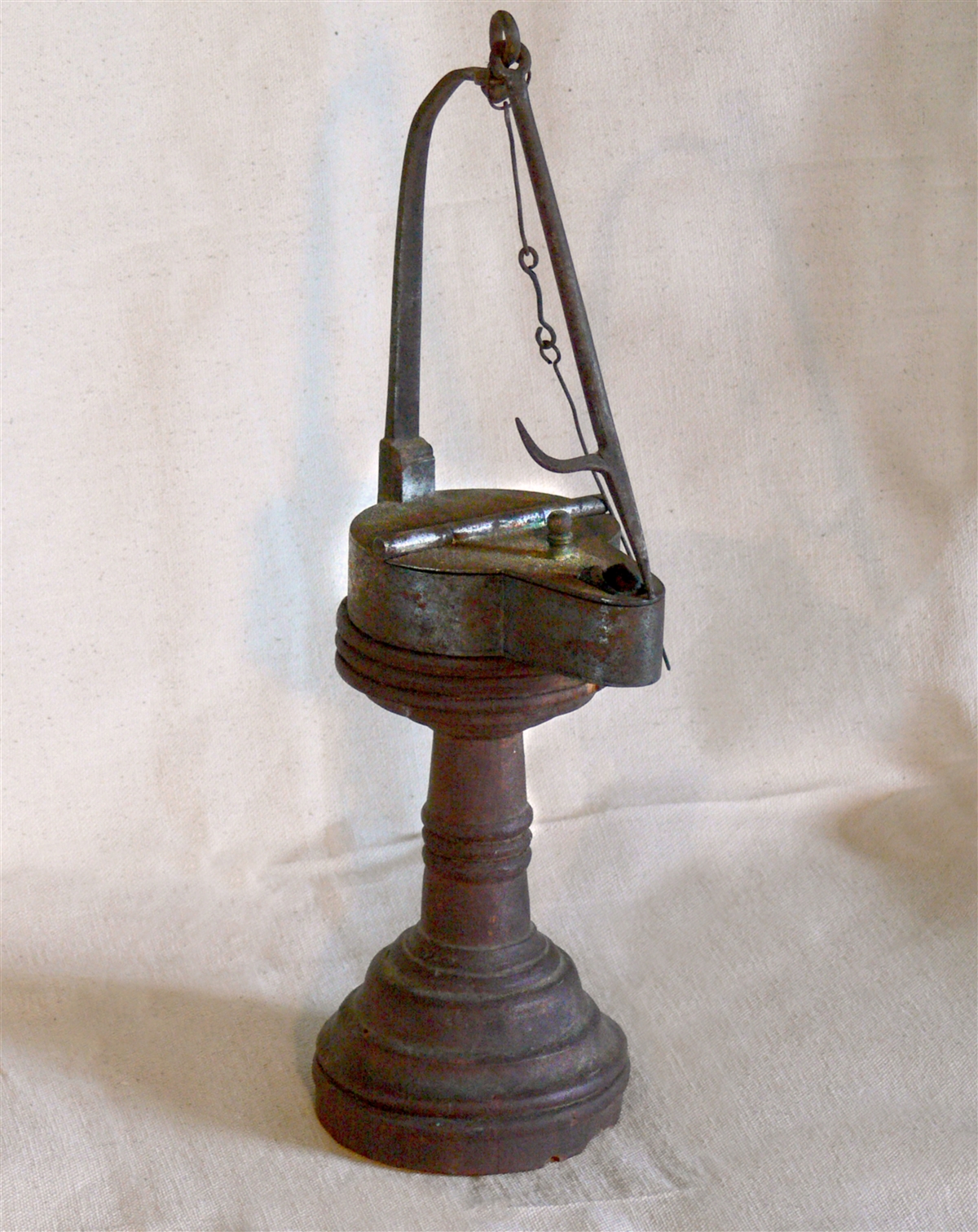
Yoder Fat Lamp: Oley Valley, Berks County, ca. 1750
This fat-burning lamp with its custom stand of turned wood was used at the 1741 homestead of Johannes and Anna Rosina Yoder built in the Oley Valley. These lamps traditionally burned leftover cooking fat, such as lard, and the full metal construction warmed the lard in the lamp reservoir to keep it fluid. The lamp is equipped with a hook for hanging on the edge of a mantle or other fixture, as well as a long pin to advance the wick.

Maria Seebold Embroidered Towel: Southeastern Pennsylvania, mid-19th century
Highly embroidered towels, like this example by Maria Seebold, were commonly produced by young women of marrying age as a demonstration of their skill in embroidery and lace. Often featuring names, and dates, and sometimes religious motos, this particular form was especially popular among the Mennonite and Schwenkfelder communities in Lancaster, Montgomery, Berks, and Lebanon Counties in the mid-19th century.

Morel Harvesting Basket: Franklin County, Pennsylvania, ca. 1850
This elaborate harvesting basket complete with attached lid and a sapling handle, was woven of rye straw, and used for harvesting wild morel mushrooms – a springtime delicacy among the Pennsylvania Dutch. The lid allowed the mushrooms to be kept cool and out of the sun while out on harvesting excursions in wooded areas.
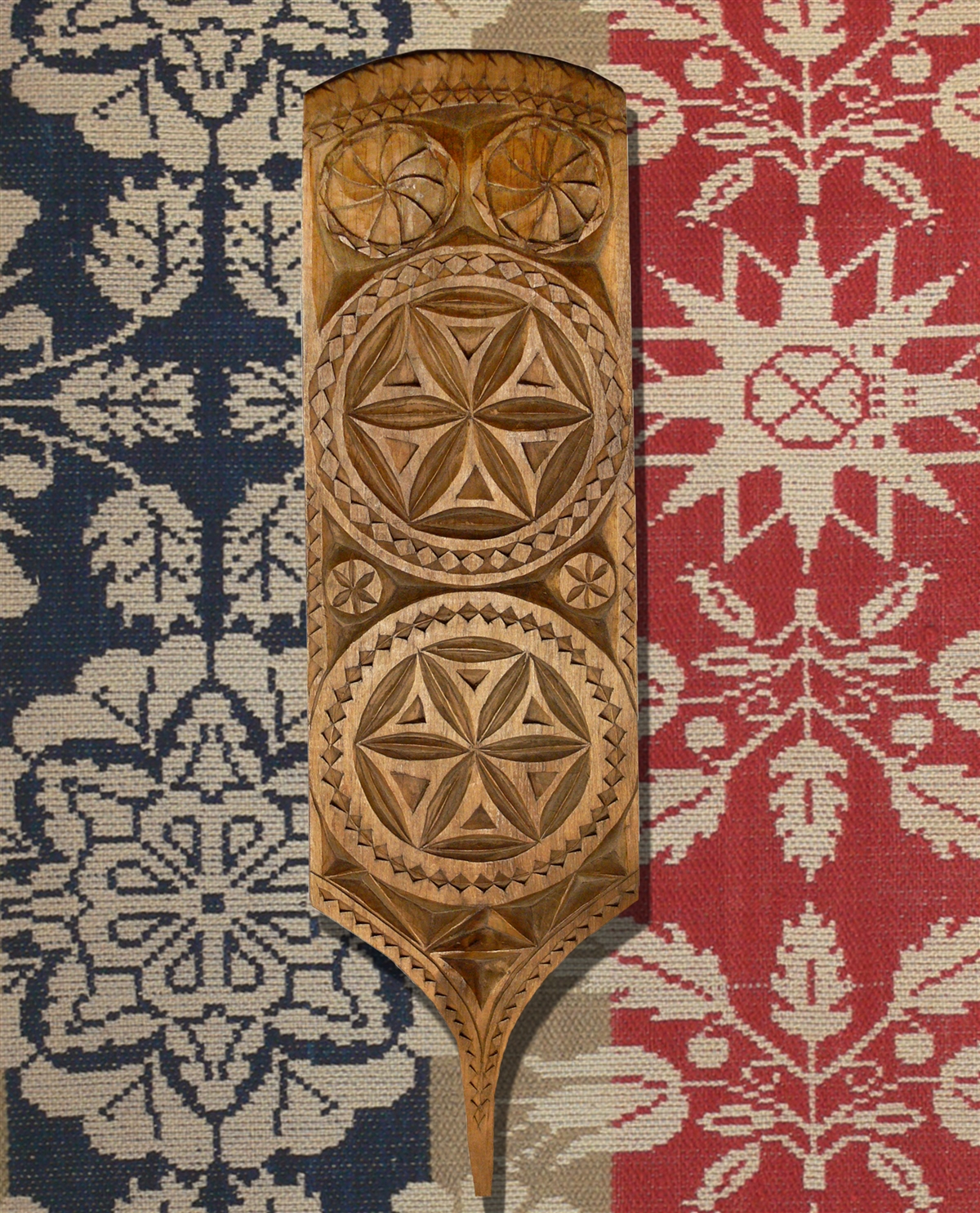
Chip-Carved Mattress Paddle: Pennsylvania, mid-19th century
An elaborately carved wooden paddle used for preparing and smoothing a rye-straw mattress tick on a nineteenth-century rope bed. Such highly embellished objects were typically carved during winter evenings and presented as gifts for sweethearts or loved ones. Some of these objects were dated and initialed to demonstrate a sense of pride in craftsmanship, while others, like the paddle, are anonymous and without attribution.
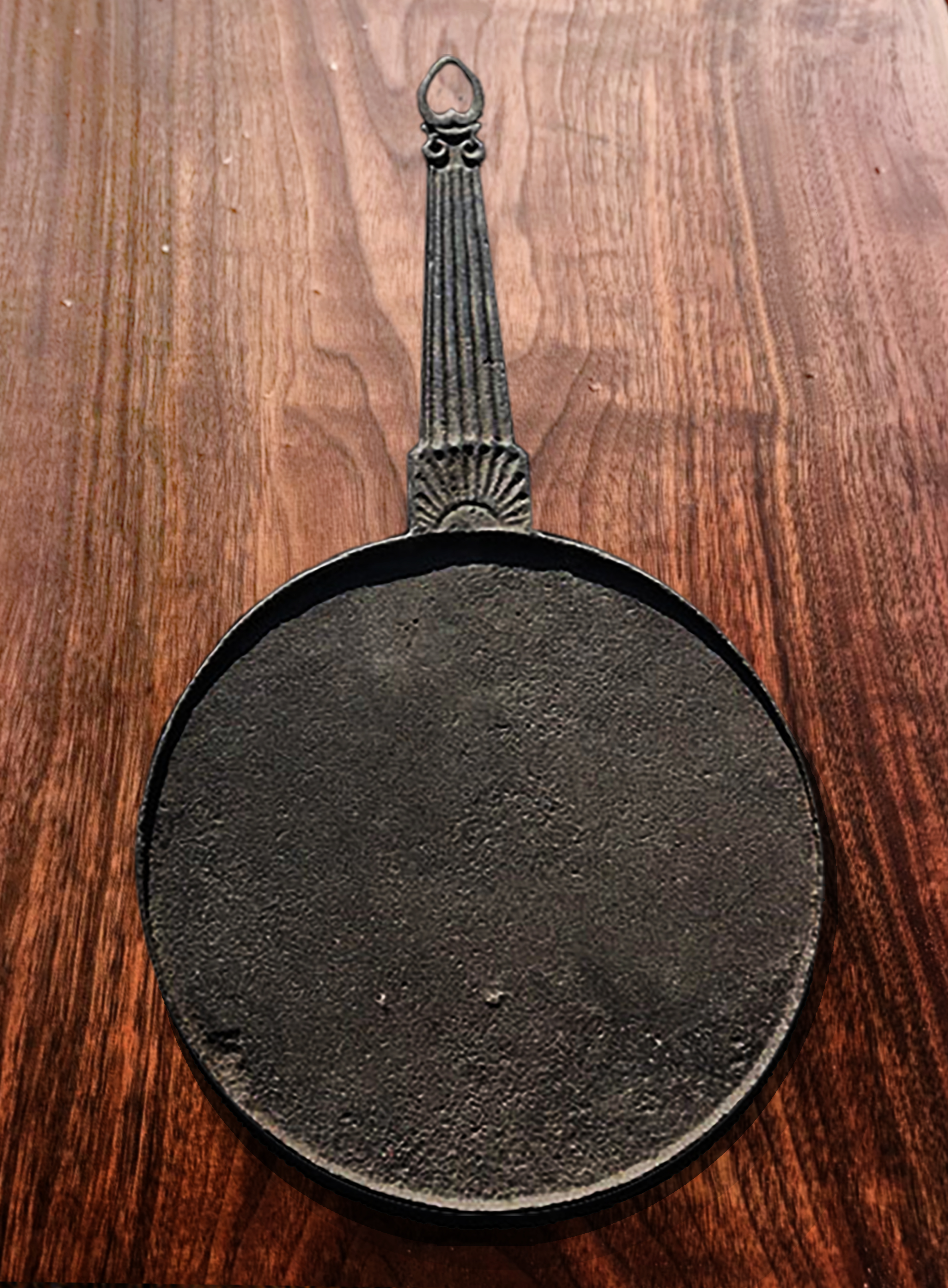
Cast Iron Hearth Griddle: Berks County, Pennsylvania, ca. 1815
This iron griddle with three legs on the underside was designed for cooking on an open hearth over hardwood coals. The long ornate handle featuring a rising sun and heart pattern was characteristic work of a local foundry that produced stove plates, cauldrons, and other utilitarian cast-iron wares.

Moravian Brettschtuhl: Oley Valley, Berks County, late 18th-century
This early wooden stool was used in the 1746 Moravian half-timbered school house in Oley. Constructed in the classic Central European style, with a decorative back tenoned into a solid plank seat, and splayed octagonal legs, this chair was salvaged from the school house just before it was torn down around 1955.
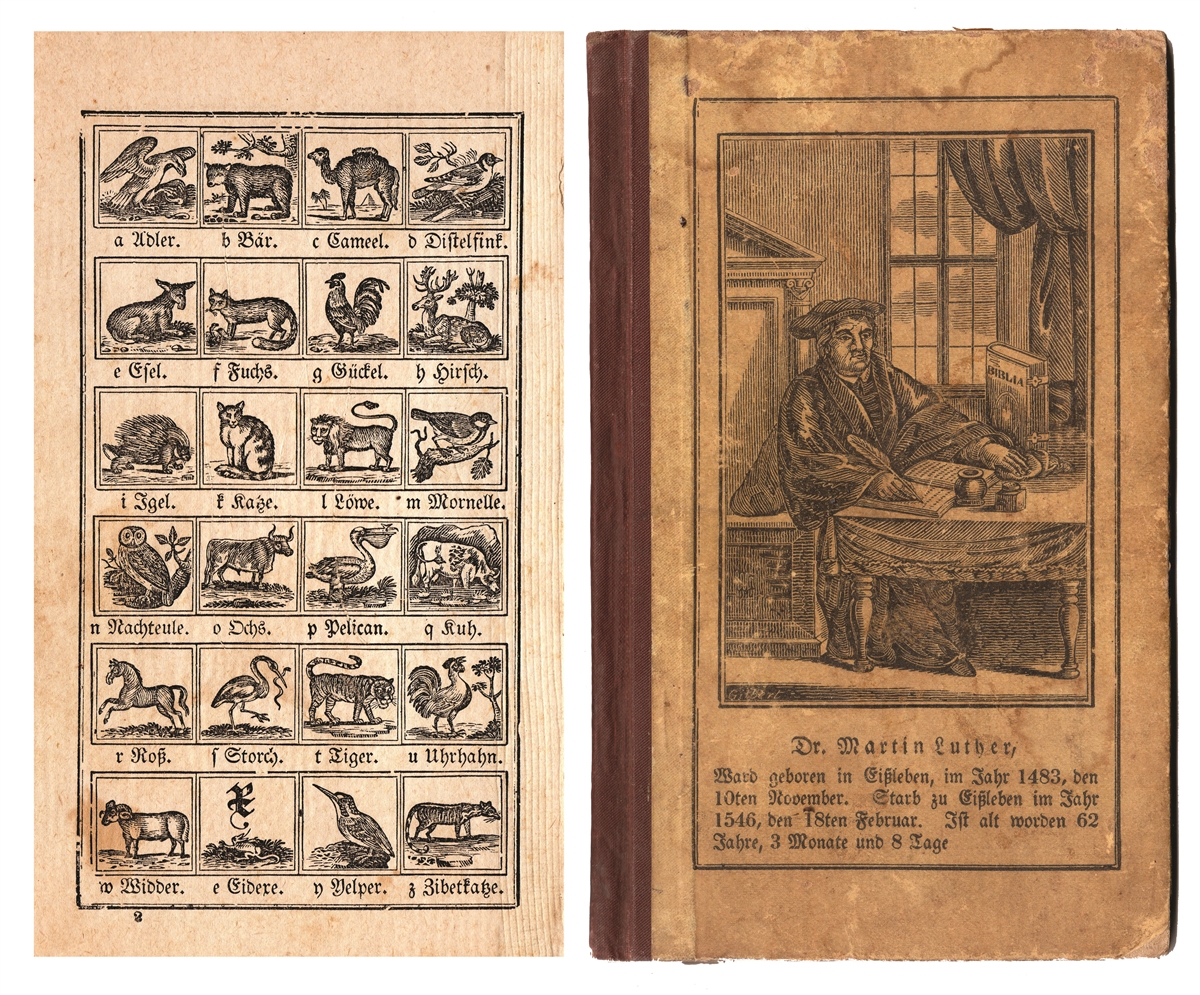
German ABC-Book: Philadelphia: Shaefer & Koradi, ca. 1840
German-language ABC books were among the first readers issued to students in local schools, and their classic forms remained constant throughout the early and mid-19th century. The frontis chart of the alphabet depicts images from “Adler” (eagle) to “Zibetkatze” (Civet-cat). As some schools were associated with local churches, Lutheran congregations furnished copies of the spelling book with Dr. Martin Luther on the cover, while Reformed congregations favored the image of David with his harp.
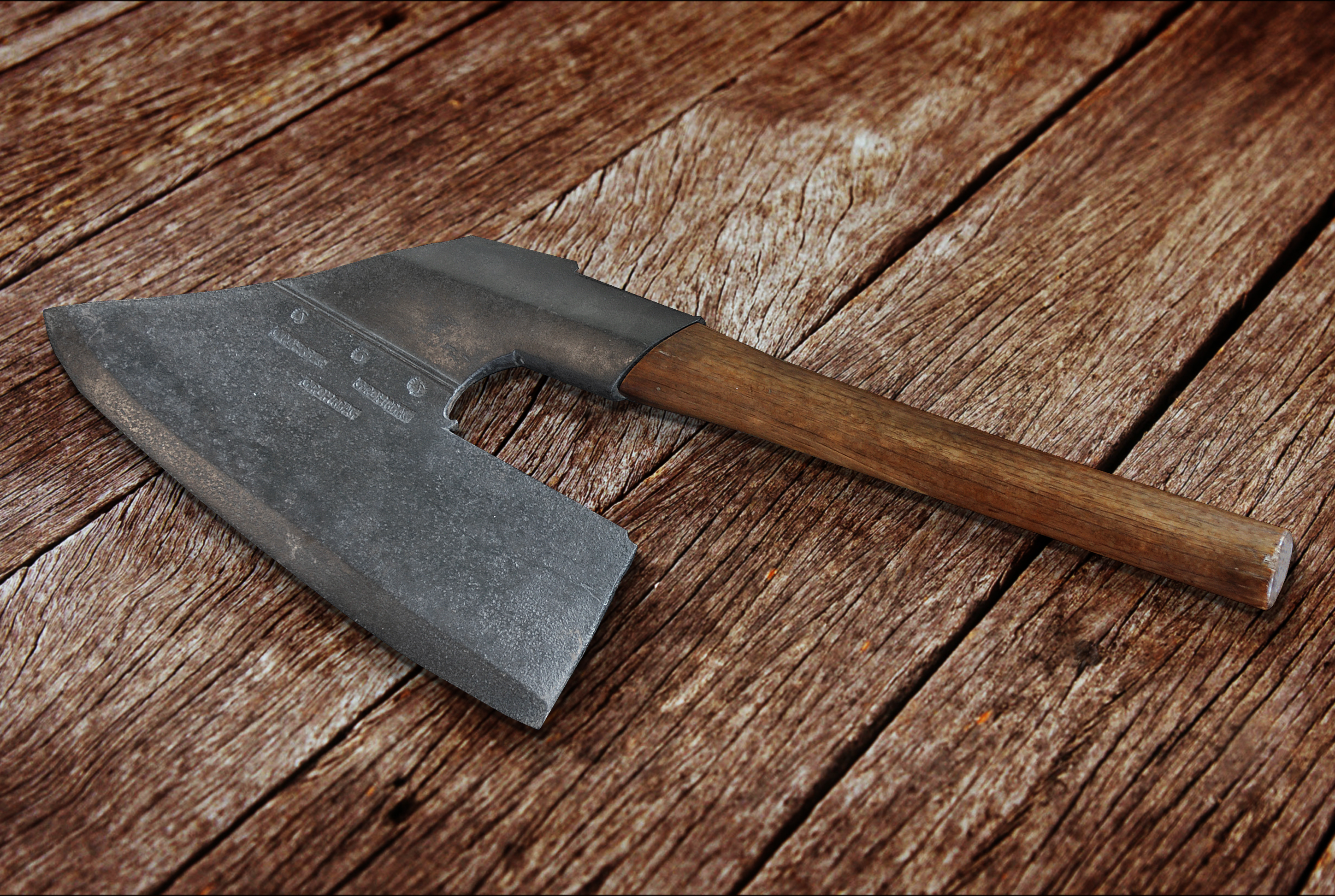
G. Rohrbach Goosewing Axe: Kutztown, Pennsylvania, ca. 1790
Broadaxes were the tool of choice for hewing and squaring timbers used in building barns, houses, mills, and other structures in the early Pennsylvania landscape. German-speaking settlers in the 18th century preferred the “goosewing” style, with an offset handle and distinctive blade shape. Many expert toolmakers, such as G. Rohrbach of Kutztown, signed their work with a signature stamp.
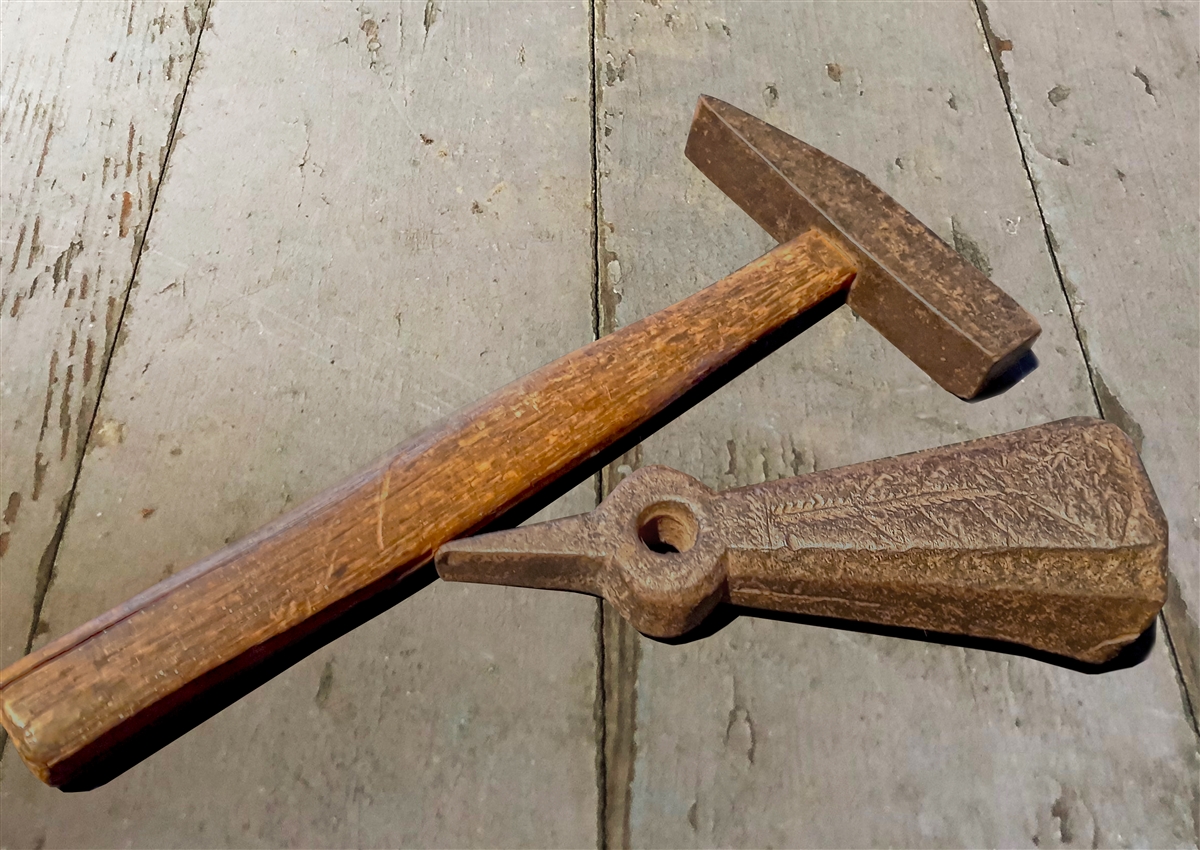
Dengelschtock & Dengelhammer: Pennsylvania, ca. 1800 & 1840
Pennsylvania Dutch farmers sharpened their valuable grain scythes not with a grindstone, but with a peening anvil called a Dengelschtock. The anvil was typically driven into a stump and the metal blade of the scythe was drawn out carefully with a hammer used specially for the process called a Dengelhammer. This process preserved the metal scythe blades and kept them from being worn down by grinding, which ultimately wasted the metal. The Dengelschtock was seen as a symbol of frugality.






















